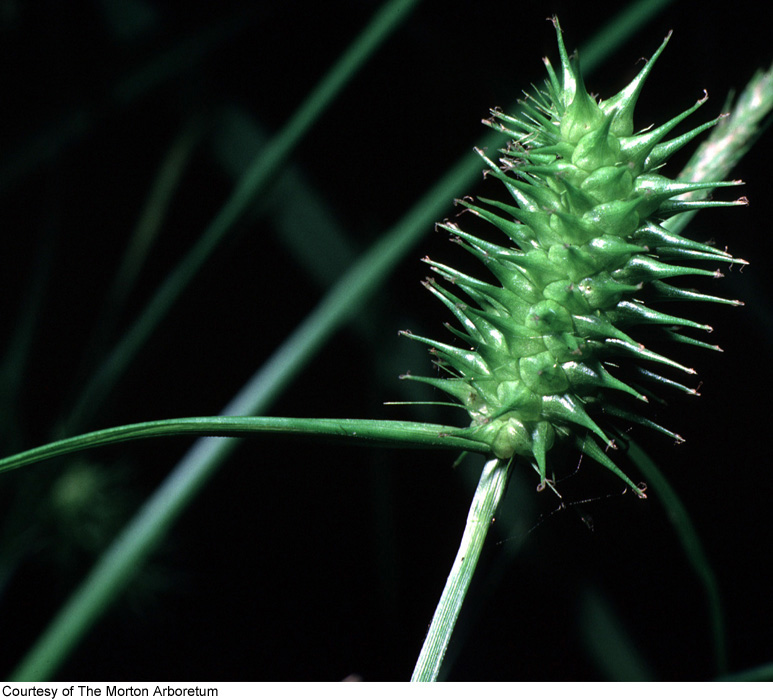Plants densely to loosely cespitose; rhizomes short, no more than 10 cm. Culms sharply trigonous in cross section, (15-)25-95(-110) cm, scabrous-angled distally. Leaves: basal sheaths reddish purple; ligules as wide to slightly longer than wide; blades dark green, flat to W-shaped, widest leaves (4-)4.5-11.5(-13) mm wide, glabrous. Inflorescences 2.7-18 cm; proximal bract 9-45 cm, exceeding inflorescence; proximal 1-3(-4) spikes pistillate, erect or the proximal often spreading, (12-)15-22 mm thick, if spikes less than 15 mm thick, then usually less than 2.5 times as long as wide; terminal 1 spike staminate. Pistillate scales narrowly oblong, 3.4-11.2 × 0.5-1.1 mm, as long as or shorter than perigynia, margins often ciliate, apex truncate to retuse, erose, prolonged to scabrous awn. Staminate scales with distinct, scabrous awn, sometimes ciliate-margined. Perigynia spreading, strongly 7-12-veined, veins separate nearly to beak apex, broadly ovate, (6-)6.5-10.8 × (1.8-)2-3.5(-4.2), apex contracted; beak 2.5-5.9 mm, 0.7-0.9 length of body, bidentate, smooth, teeth straight, to 0.2-0.8 mm. Stigmas 3. Achenes yellow to brown, trigonous, papillose.
Fruiting May-Aug. Wet meadows, marshes, seeps, shores of ponds, lakes, and streams, open swamp forests, ditches, mostly in acidic, often sandy soils; 0-1200 m; Nfld. & Labr., N.S., Ont., Que.; Ala., Ark., Conn., D.C., Fla., Ga., Ill., Ind., Ky., La., Maine, Md., Mass., Mich., Miss., Mo., N.H., N.J., N.Y., N.C., Ohio, Okla., Pa., R.I., S.C., Tenn., Tex., Vt., Va., W.Va., Wis.; Mexico, West Indies, South America.
Carex lurida is an abundant, variable, and often weedy species. A few specimens appear to be hybrids of C. lurida with C. lupulina.
Very common; in southern Indiana ubiquitous in swamps, sloughs, ditches, and wet habitats of all types. Carex lurida is frequently confused with C. hystricina and with C. lupulina. The following distinctions, in addition to those given in the key to the sections, may be useful in separating it from these. The achene of C. lurida is strongly rough-papillate; that of C. lupulina is perfectly smooth. Also the teeth of the perigynia in C. lurida are very short (averaging 0.5 mm long) and the stigmas all protrude from one side; in C. lupulina the teeth are long (0.75-2 mm) and the stigmas radiate irregularly from the orifice. In C. hystricina the teeth of the perigynia are longer and spreading or ascending; in C. lurida the teeth are erect or appressed, the perigynia are more abruptly beaked and the beak is longer and narrower.
Tufted, without long rhizomes; stems aphyllopodic, 2-10 dm, usually surpassed by the lvs, obtusely trigonous and smooth or nearly so, purplish at base; lvs septatenodulose, with flat blade (2-) 4-7 mm wide; ligule triangular, distinctly longer than wide; terminal spike staminate, 1-7 cm, its scales with the midrib prolonged into an evident awn; pistillate spikes 1-4, approximate, or the lower remote, sessile and erect or (especially the lower) evidently pedunculate and even drooping, 1-7.5 נ1.4-2 cm, densely fld; bracts leafy, surpassing the infl, with or without a sheathing base; pistillate scales rough-awned, or the upper merely acuminate; perigynia numerous, in many rows, 6-9 mm, ovoid or ovoid-globose, somewhat inflated, pale, smooth and shining, strongly ca 10-nerved, with a slender, bidentate beak half to almost as long as the body; achene concavely trigonous, densely granular, loosely enveloped in the lower part of the perigynium, the persistent style twisted or abruptly bent. Swamps and wet meadows and woods; N.S. to Minn., s. to Fla. and Mex.
Gleason, Henry A. & Cronquist, Arthur J. 1991. Manual of vascular plants of northeastern United States and adjacent Canada. lxxv + 910 pp.
©The New York Botanical Garden. All rights reserved. Used by permission.







